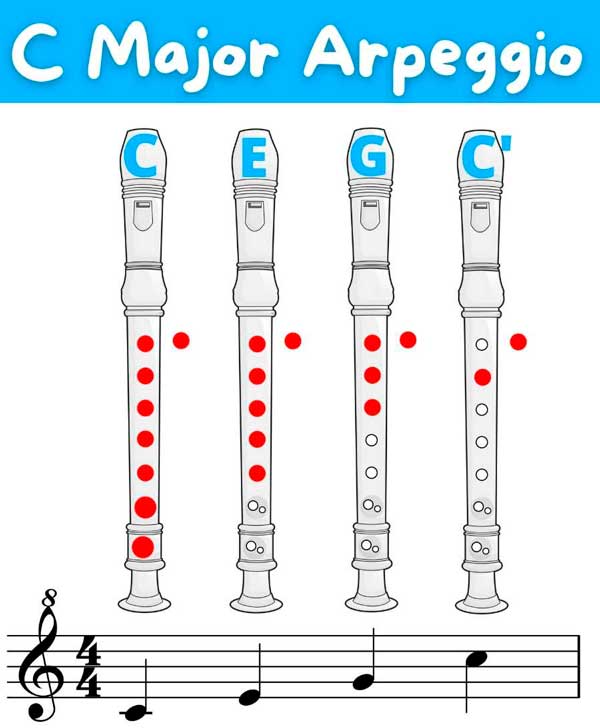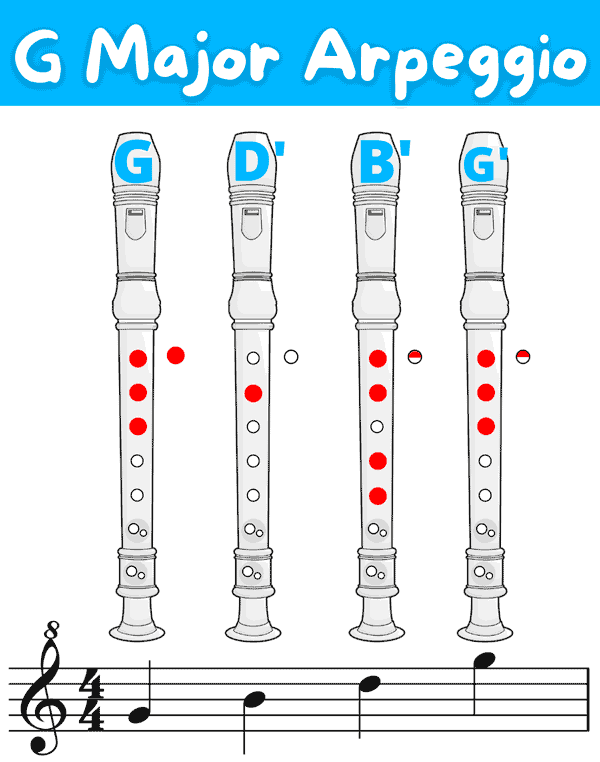Learning recorder arpeggios is a powerful way to improve technique, finger coordination, and musical understanding. If you already know your recorder scales, arpeggios are the natural next step. In this lesson, you’ll learn what arpeggios are, how to play them, and beginner-friendly exercises in C major and G major.
What is an Arpeggio?
An arpeggio is the notes of a chord played one after another instead of all at the same time (from the Italian arpeggiare, “to play like a harp”).
- A C major chord contains the notes C–E–G.
- The C major arpeggio plays those notes in sequence: C, E, G (and usually back to C), ascending and descending.
Arpeggios help recorder players focus on the most important notes of each key and appear frequently in melodies, accompaniments, and improvisation.
Why Practice Recorder Arpeggios?
- Better technique: Improve finger coordination and smooth note transitions.
- Harmony made practical: Understand chords and harmony, not just scales.
- Musical application: Arpeggios appear in many songs and classical pieces.
- Ear training: Recognize the sound of major and minor chords.
Recorder Arpeggios in C Major
The C major arpeggio uses the notes C – E – G – C. Start slowly and make sure each note is clear. First play it ascending (going up), then descending (going down).

Practice tip: Aim for even tone and rhythm. Don’t rush—focus on smooth finger changes.
Recorder Arpeggios in G Major
The G major arpeggio uses the notes G – B – D – G. In the G major scale you’ll also meet F♯, so make sure you’re comfortable with that fingering before practicing faster tempos.

Practice tip: Repeat the arpeggio two or three times in a row, keeping the tempo steady.
How to Practice Recorder Arpeggios Effectively
- Start slow: Use a metronome and begin at a comfortable speed.
- Steady breath: Keep the air flow consistent for a smooth tone.
- Both directions: Always practice ascending and descending.
- Rhythm variations: When comfortable, try quarters, eighths, and triplets.
- Stay relaxed: Avoid finger tension, especially at faster tempos.
Next Steps
After mastering C major and G major arpeggios, explore other keys like D major, F major, and A minor. Each new arpeggio expands your technique and prepares you for more advanced music. Watch for our upcoming lessons on minor arpeggios and seventh-chord arpeggios for recorder.
Don’t Forget to Practice Your Scales!
While recorder arpeggios are a fantastic way to improve your technique, never forget the importance of practicing recorder scales on a daily basis. Scales are the foundation of music: they develop your finger agility, strengthen your breath control, and give you the ability to play in any key with confidence. Without scales, arpeggios and melodies become much harder to play smoothly.
If you want to make faster progress, combine your arpeggio practice with regular scale exercises. For example, after playing the C major arpeggio, review the C major scale up and down. This connection helps you understand how arpeggios are built from scales and how both are used in real music.
👉 For a complete guide, don’t miss our dedicated Recorder Scales Section right here on this website. In that section you’ll find:
-
Easy-to-read fingering charts for every scale
-
Step-by-step explanations for beginners
-
Audio examples to help you develop your ear
-
Practice tips for smooth and accurate playing
Practicing both scales and arpeggios will make you a stronger recorder player, prepare you for more advanced pieces, and give you the skills to enjoy music at a higher level.

